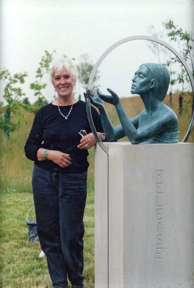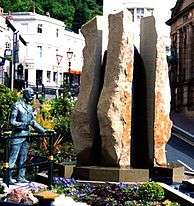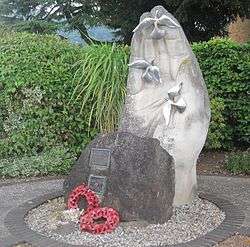Rose Garrard

Rose Garrard (born 21 September 1946,[1] Bewdley, Worcestershire, England) is an installation, video and performance artist, sculptor, and author. Her artworks have been acquired by collections worldwide including the New South Wales government Art Gallery in Australia.[2]

Historian and author
Garrard became heavily involved with the restoration of the local springs and the history of Malvern, Worcestershire, and her research carried out in 2006 demonstrated for the first time that well dressing has been part of tradition in the Malvern area since the 12th and 13th centuries.[3][4] In 2001, she began organising the well dressing campaign in Malvern which has become an annual event with over 28 wells being dressed.[4]
As an author, Garrard has written three books based on Malvern, including two about aspects of the springs, and A Malvern Treasury published in 2010, that was written on the recommendation of a local bookshop, Beacon Books, due to previous comprehensive histories of the town by other authors being out of print.[5]
Art

Garrard's parents were also involved in art, and while she was still a baby, the family moved to Malvern, Worcestershire where her mother owned an antique shop, and her father continued a career as an artist and soldier as director of the Middle East College of Art in the Sahara Desert.[6] For 30 years Garrard was based in London and internationally known as a multi-media artist and curator, but following a serious motor bike accident she moved back to Worcestershire in 2000, focussing instead on making public sculpture.[6] She creates these works using many media including plaster of Paris, bronze, stone, slate, and brick.[7]
Among her sculptures are the Enigma Fountain including the statue of Sir Edward Elgar (Unveiled by The Duke of York on Belle Vue Terrace, Great Malvern on 26 May 2000).[8] Its cost of £50,000 was funded by the Malvern Hills District Council, public subscription, and support from by West Midlands Arts, Severn Trent Water, and local businesses. Other works include the drinking spout, Malvhina, which was unveiled on 4 September 1998, the Hand of Peace war memorial, a sculpture in Portland stone located in the Barnards Green suburb of Malvern,[9] Women's Work 1998, in Bilston, Wolverhampton, England, created in bronze, Welsh slate, and brick,[10] and the Cascade Gates 2007, in welded steel at the Clock Tower Well Room in North Malvern.
Garrard's works have also been exhibited at the Victoria and Albert Museum, the Tate Gallery, the British Council maintained Great Britain pavilion at the 1984 Venice Biennale (1984),[11] and national galleries in Austria and Canada.[6]
Publications

- Malvern: Hill of Fountains – Ancient Origins, Beliefs and Superstitions surrounding Wells and Well Dressing (2006) Aspect Design ISBN 1-905795-01-7
- Donkeys’ Years on the Malvern Hills (2008) Aspect Design ISBN 978-1-905795-18-5
- A Malvern Treasury, (2010) Aspect Design ISBN 978-1-905795-56-7
- archiving my own history : documentation of works, 1969–1994. (1994) Cornerhouse, Manchester ISBN 1-897586-07-8, ISBN 978-1-897586-07-5, OCLC 31381367
- Talisman (1988) Louise Hallett Gallery, 1988. ISBN 0-9513047-2-0, ISBN 978-0-9513047-2-3, OCLC 19269136
- Redressing the balance (1987) Neue Gesellschaft für Bildende Kunst, Berlin. OCLC 18993481
References
- ↑ "Birthdays". The Guardian. Guardian News & Media. 20 September 2014. p. 56.
- ↑ "Art Gallery NSW". Government of New South Wales. Retrieved 16 February 2011.
- ↑ "Well dressing". Malvern Wells parish council. Retrieved 16 February 2011.
- 1 2 "MALVERN WELL DRESSING HISTORY". Malvern Spa Association. Retrieved 16 February 2011.
- ↑ "New book outlines history of Malvern". Malvern Gazette. Newsquest Media Group. 2 April 2010. Retrieved 16 February 2011.
- 1 2 3 "Rose Garrard, autobiographical web site". Retrieved 16 February 2011.
- ↑ "GCSE – Bitesize". BBC. Retrieved 16 February 2011.
- ↑ "Malvern's water". malvern-hills.co.uk. Retrieved 16 February 2011.
- ↑ Brooks, Alan; Pevsner, Nikolaus (2007). Worcestershire: The Buildings of England. Pevsner Architectural Guides. Yale University Press. p. 483. ISBN 978-0-300-11298-6.
- ↑ Noszlopy, George T; Waterhouse, Fiona (2005). Public Sculpture of Staffordshire and the Black Country. Liverpool University Press. p. 25. ISBN 978-0-85323-989-5.
- ↑ "UK at the Venice Biennale 1984". British Council. 2009. Retrieved 7 December 2011.
Further reading
- Rideal, L (1984) From Myth to Reality : A profile of Rose Garrard. 'Performance Journal', University College London (32) 20 – 23.
- Bunting Brunch, Anna, Interviews Rose Garrard: "Frames of Reference". n.paradoxa vol. 30, 2012.